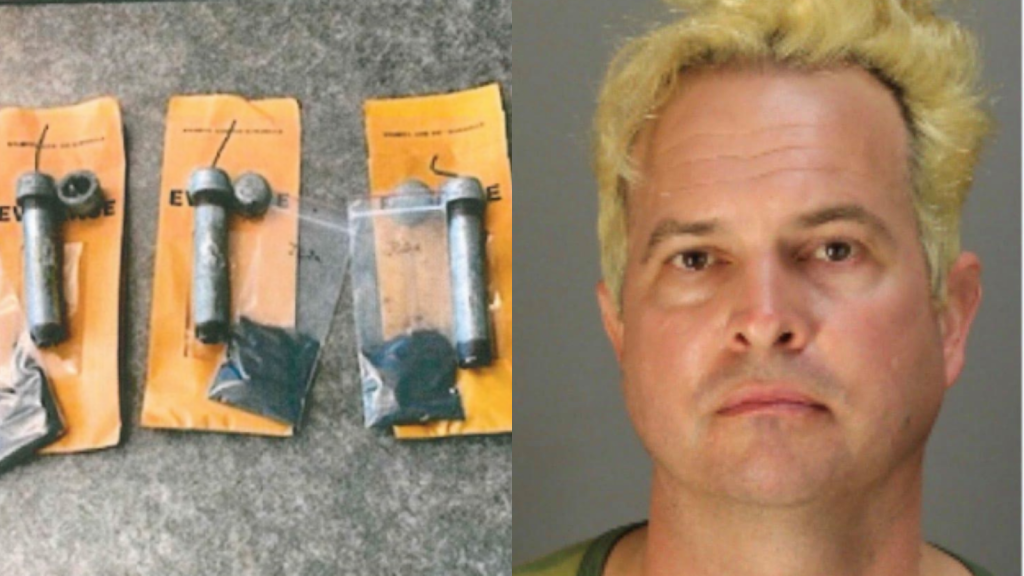Want the best of VICE News straight to your inbox? Sign up here.
Two militia men from Northern California built pipe bombs, stockpiled dozens of guns and thousands of rounds of ammo, pounded steroids, and plotted to attack Democrat headquarters in Sacramento, prosecutors say. Their goal, according to recently unsealed court documents, was “to go to war” against Democrats, and through intimidation, undo the results of the 2020 election, and ensure former President Donald Trump’s second term in office.
Videos by VICE
Jarrod Copeland and Ian Rogers, who are part of a militia group linked to the Three Percenter network, are facing federal and state charges for their “specific, detailed, and serious” plot to attack a government building, destroying evidence, assembling bombs, and owning illegal machine guns.
Prosecutors say the two men started hatching their plot on November 25, a few weeks after Joe Biden was declared the winner of the presidential election.
“It will send a fucking message, man… Scare the whole country,” Rogers told Copeland in text messages recovered by the government.
They initially talked about attacking the governor’s mansion but then shifted focus to the Democratic headquarters in Sacramento. According to prosecutors, they spent nearly two months planning their attack: they reviewed maps of the building’s layout, and discussed weaponry in-depth. They weighed various options; riddling it with gunfire, setting pipe bombs, or fire-bombing it.
“I think . . . we will get tagged as domestic terrorists,” Copeland told Rogers, according to court documents. “Like I care what we are labeled,” Rogers replied. “I just hope our actions will make others get involved.”
The exchanges between Copeland and Rogers included in court documents offer a glimpse into the intense anger and violent ideation that was rumbling in far-right MAGA-world following the election, and leading up to the January 6 insurrection at the Capitol.
“I’ve had enough, time to wake people up,” Rogers wrote to Copeland on November 27. “The deep state is disgusting. 2 men can change the world if we want to.”
“We don’t need to win over 50,000 people we need 500 pissed off patriots that want America back,” Copeland replied.
The climate in the U.S. remains tense six months after Biden took office, with many Republicans, including Trump and elected officials, continuing to promote the conspiracy theory that the election was stolen.
The Department of Homeland Security issued a National Terrorism Advisory bulletin in May (which remains in effect) warning of a heightened threat environment across the U.S. They outline a range of threats, including ideologically-motivated “violent extremists fueled by perceived grievances, false narratives, and conspiracy theories.”
Prosecutors warn that this constitutes fertile ground for potential acts of violence—and argue that Copeland and Rogers should remain in jail pending the outcome of the trial.
“[Copeland] and Rogers were animated by [the] kind of anger that will not be abated or deterred by a court order,” they wrote. “All of the political and social conditions that motivated them to plan what they described themselves as a terrorist attack remain.”
As Trump’s various legal challenges to the outcome of the election sputtered, and Congress’ certification of the results on January 6 approached, Rogers and Copeland became increasingly resolute in their plan, prosecutors say. “It will probably happen and we will become outlaws for real,” Copeland said.
The two men were also seemingly looking to recruit others to help them with the attack. “We need help though and I don’t know how to get more people involved,” Rogers said on January 4. “Proud Boys and 3%,” Copeland replied. “I emailed Proud Boys.” Prosecutors said they found a URL on Copeland’s computer that suggested he had contacted or attempted to contact the Proud Boys. However, there is no evidence to currently suggest that they responded or had anything to do with this case.
The duo also embraced the idea of martyrdom. “Heads must be taken,” Copeland told Rogers. “I don’t like to think it but I think we will have to die for what we believe in.”
Even after the violent insurrection at the Capitol on January 6, the men remained focused. “I’m not going down without a fight,” Rogers told Copeland five days later. “These commies need to be told what’s up.”
“I agree,” Copeland replied. “Plan attack.”
“After the 20th, we go to war,” Rogers said, presumably in reference to the date of Biden’s inauguration.
On January 15, Napa County Sheriff’s deputies searched Rogers home and business, and seized “between 45 and 50 firearms, including at least three fully-automatic weapons, thousands of rounds of ammunition, and five pipe bombs.” It’s not clear what led authorities to Rogers, but they arrested him that day for possession of illegal machine guns and explosives. News reports of Rogers’ arrest at the time also noted that he had a “white privilege” card in his possession.
When Copeland found out Roger was arrested, he immediately contacted members of their militia (which isn’t named in the court documents). The leader of the militia suggested that Copeland switch to a new encrypted app and delete everything he had, prosecutors say. Law enforcement searched Copeland’s residence in Vallejo on January 17, and noticed that messages that they’d located on Roger’s phone were missing from Copeland’s phone.
When police searched Copeland’s residence, they also discovered a “go bag” containing food, clothing, ID cards (including passports), tactical gear, steroids, rifle and pistol magazines, and zip tie handcuffs. Copeland wasn’t arrested until earlier this week.
Both Copeland and Rogers are facing up to 20 years on conspiracy charges if convicted. Rogers is looking at an additional 10 years on weapons charges, and Copeland could get hit with another 20 years for obstructing justice by allegedly destroying evidence.
Rogers’ next court date is July 30; Copeland’s is July 20.
Follow Tess Owen on Twitter.





